【C++】类和对象(中)
@[toc]
开始之前,我想说的是,此篇博客花了较长时间,字数比较多,请耐心食用😄
一、类的6个默认成员函数
开始之前,我们很有必要先了解类的6个默认成员函数。👇
如果一个类中什么成员都没有,简称为空类。空类中什么都没有吗?并不是的,任何一个类在我们不写的情况下,都会自动生成下面
6个默认成员函数。

在这个地方,对于这6个默认成员函数,前面四个是比较重要的。废话不多说,我们直接进入主题👇
二、构造函数
我们先来看一下代码:
#include <iostream>
using namespace std;
class Date
{
public:
void SetDate(int year, int month, int day)
{
_year = year;
_month = month;
_day = day;
}
void Display()
{
cout << _year << "-" << _month << "-" << _day << endl;
}
private:
int _year;
int _month;
int _day;
};
int main()
{
Date d1, d2;
d1.SetDate(2018, 5, 1);
d1.Display();
Date d2;
d2.SetDate(2018, 7, 1);
d2.Display();
return 0;
}
对于Date类,可以通过SetDate公有的方法给对象设置内容,但是如果每次创建对象都调用该方法设置信息,未免有点麻烦,那能否
在对象创建时,就将信息设置进去呢 ❓构造函数可以帮我们解决这个问题。
构造函数是一个特殊的成员函数,名字与类名相同,创建类类型对象时由编译器自动调用,保证每个数据成员都有 一个合适的初始值,并且在对象的生命周期内只调用一次
特性
构造函数是特殊的成员函数,需要注意的是,构造函数的虽然名称叫构造,但是需要注意的是构造函数的主要任务并不是开空间创建对象,而是初始化对象。
其特征如下:
- 函数名与类名相同。
- 无返回值。
- 对象实例化时编译器自动调用对应的构造函数。
- 构造函数可以重载。
下面我们来看一看构造函数基本的代码:
#include <iostream>
using namespace std;
class Date
{
public:
//无参构造函数,可以进行初始化
Date()
{
}
//带参构造函数
Date(int year, int month, int day)
{
_year = year;
_month = month;
_day = day;
}
void Print()
{
cout << _year << "-" << _month << "-" << _day << endl;
}
private:
int _year;
int _month;
int _day;
};
void TestDate()
{
Date d1;
//d1.Print();
Date d2(2025,9,23);
d2.Print();
// 注意:如果通过无参构造函数创建对象时,对象后面不用跟括号,否则就成了函数声明
// 以下代码的函数:声明了d3函数,该函数无参,返回一个日期类型的对象
//Date d3();
}
int main()
{
TestDate();
return 0;
}
除此之外,如下的代码会造成二义性:(无参的构造函数和全缺省的构造函数都称为默认构造函数,并且默认构造函数只能有一个。注意:无参构造函数、全缺省构造函数、我们没写编译器默认生成的构造函数,都可以认为是默认成员函数。也就是说不传参数就可以调用的就是默认构造 )
class Date
{
public:
//无参构造函数
Date()
{
_year = 1;
_month = 1;
_day = 1;
}
//带参构造函数(全却省)
Date(int year = 1, int month = 1, int day = 1)
{
_year = year;
_month = month;
_day = day;
}
void Print()
{
cout << _year << "-" << _month << "-" << _day << endl;
}
private:
int _year;
int _month;
int _day;
};
void TestDate()
{
Date d1;
//d1.Print();
Date d2(2025, 9, 23);
d2.Print();
// 注意:如果通过无参构造函数创建对象时,对象后面不用跟括号,否则就成了函数声明
// 以下代码的函数:声明了d3函数,该函数无参,返回一个日期类型的对象
//Date d3();
}
int main()
{
TestDate();
return 0;
}
如果类中没有显式定义构造函数,则C++编译器会自动生成一个无参的默认构造函数,一旦用户显式定义编译器将不再生成 。这就涉及到了一个问题:该不该去显示的定义构造函数呢❓别急,接着往下看
我们注释掉自己定义的构造函数,然后去调用:
class Date
{
public:
/*Date(int year = 1, int month = 1, int day = 1)
{
_year = year;
_month = month;
_day = day;
}*/
void Print()
{
cout << _year << "-" << _month << "-" << _day << endl;
}
private:
int _year;
int _month;
int _day;
};
int main()
{
Date d1;
d1.Print();
return 0;
}

关于编译器生成的默认成员函数,在我们不实现构造函数的情况下,编译器会生成默认的构造函数。但是看起来默认构造函数又没什
么用?d1对象调用了编译器生成的默认构造函数,但是d1对象*year/*month/_day,依旧是随机值。也就是说在这里编译器的默认构造函
数并没有什么用❓
解答:C++把类型分成内置类型(基本类型)和自定义类型。内置类型就是语法已经定义好的类型:如int/char…,自定义类型就是我们使用class/struct/union自己定义的类型,看看下面的程序,就会发现编译器生成默认的构造函数会对自定类型成员_t调用它的默认构造函数
class Time
{
public:
Time()
{
cout << "Time()" << endl;
_hour = 0;
_minute = 0;
_second = 0;
}
private:
int _hour;
int _minute;
int _second;
};
class Date
{
private:
// 基本类型(内置类型)
int _year;
int _month;
int _day;
// 自定义类型
Time _t;
};
int main()
{
Date d;
return 0;
}

==此外,无参的构造函数和全缺省的构造函数都称为默认构造函数,并且默认构造函数只有一个。注意:无参构造函数,全缺省构造函数,我们没写编译器默认生成的构造函数,都可以认为是默认构造函数==。
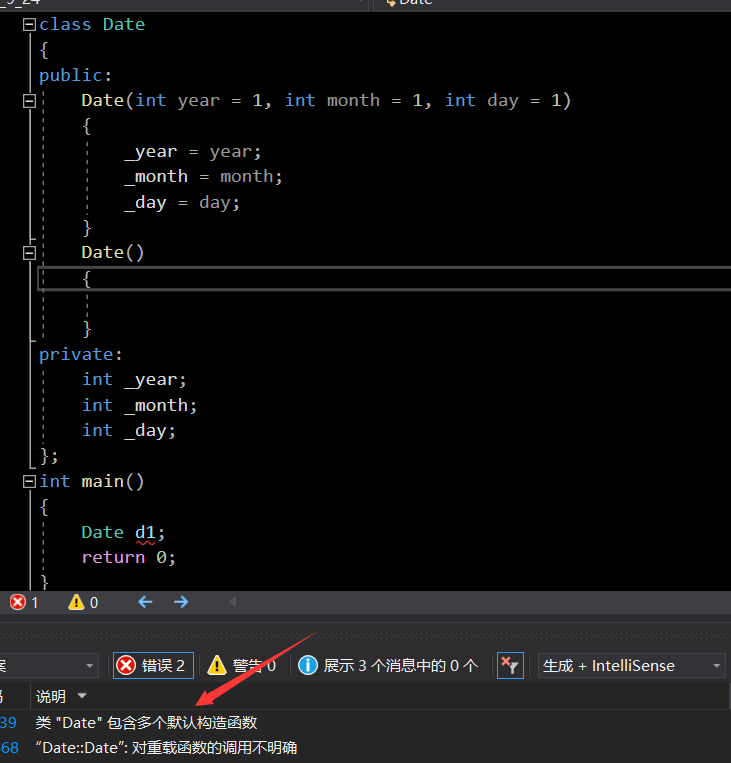
三、析构函数
前面通过构造函数的学习,我们知道一个对象时怎么来的,那一个对象又是怎么没呢的?这就引出了我们的析构函数
析构函数:与构造函数功能相反,析构函数不是完成对象的销毁,局部对象销毁工作是由编译器完成的。而对象在销毁时会自动调用析构函数,完成类的一些资源清理工作.
析构函数是特殊的成员函数。
其特征如下:
- 析构函数名是在类名前加上字符 ~。
- 无参数无返回值。
- 一个类有且只有一个析构函数。若未显式定义,系统会自动生成默认的析构函数。
- 对象生命周期结束时,C++编译系统系统自动调用析构函数。
有了构造函数和析构函数之后,就可以自动调用初始化和销毁了(不会导致自己忘记初始化和销毁了),这实际上也大大方便了我们。这里以栈为例子,引出后面的知识点:
class Stack
{
public:
Stack(int capacity = 4)
{
_a = (int*)malloc(sizeof(int) * capacity);
if (_a == nullptr)
{
perror("malloc fail");
exit(-1);
}
_top = 0;
_capacity = capacity;
}
~Stack()
{
free(_a);
_a = nullptr;
_top = _capacity = 0;
}
void Push(int x)
{
_a[_top++] = x;
}
private:
int* _a;
int _top;
int _capacity;
};
int main()
{
Stack A;
return 0;
}
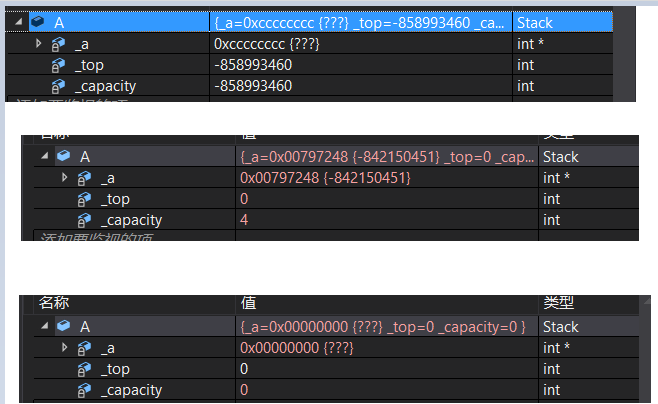
那对于系统默认生成的析构函数呢,情况又是如何的,这值得我们去学习❓
关于编译器自动生成的析构函数,我们通过下面的程序会看到,==编译器生成的默认析构函数,会对自定类型成员调用它的析构函数== :
class String
{
public:
String(const char* str = "hello")
{
_str = (char*)malloc(strlen(str) + 1);
assert(_str);
strcpy(_str, str);
}
~String()
{
cout << "~String()" << endl;
free(_str);
}
private:
char* _str;
};
class Person
{
private:
String _name;
int _age;
};
int main()
{
Person p;
return 0;
}
四、拷贝构造函数
在创建对象时,可否创建一个与一个对象一模一样的新对象呢 ❓只要思想不滑坡,办法总比困难多,此时我们的拷贝构造函数也来了
拷贝构造函数:只有单个形参,该形参是对本类类型对象的引用(一般常用const修饰),在用已存在的类类型对象创建新对象时由编译器自动调用
举个简单的例子(这里直接用系统默认生成的拷贝构造函数了,只是先看一下是怎么用的):
class Date
{
public:
Date(int year=1, int month = 1, int day = 1)
{
_year = year;
_month = month;
_day = day;
}
private:
int _year;
int _month;
int _day;
};
int main()
{
Date d1(2022,9,24);//构造
//拷贝d1
Date d2(d1);//拷贝构造--拷贝初始化
return 0;
}
特征如下
拷贝构造函数也是特殊的成员函数,其特征如下:
- 拷贝构造函数是构造函数的一个重载形式。
- 拷贝构造函数的参数只有一个且必须使用引用传参,使用传值方式会引发无穷递归调用。
对于第2点,采用传值方式编译器会报错(编译器检查比较严格),如果不报错就会引发无穷递归调用:
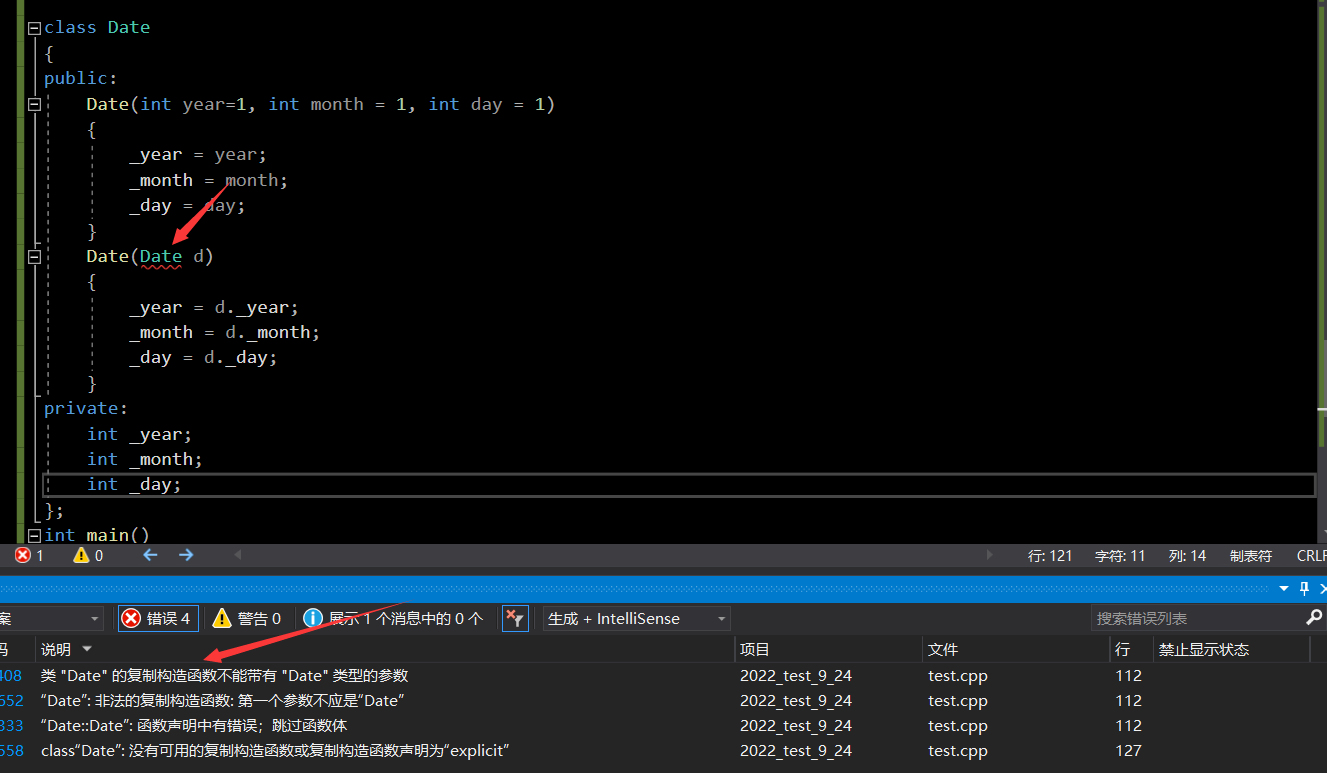
正确的做法是引用:
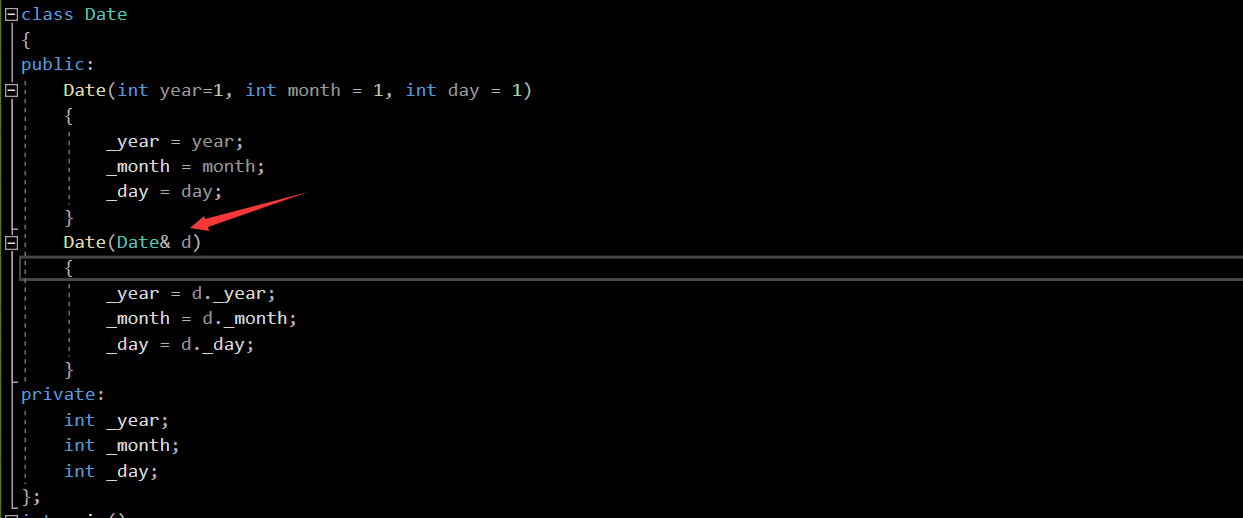
这里存在一个问题:为什么传值会引发无穷递归呢(当然我们这里的编译器有检查)❓
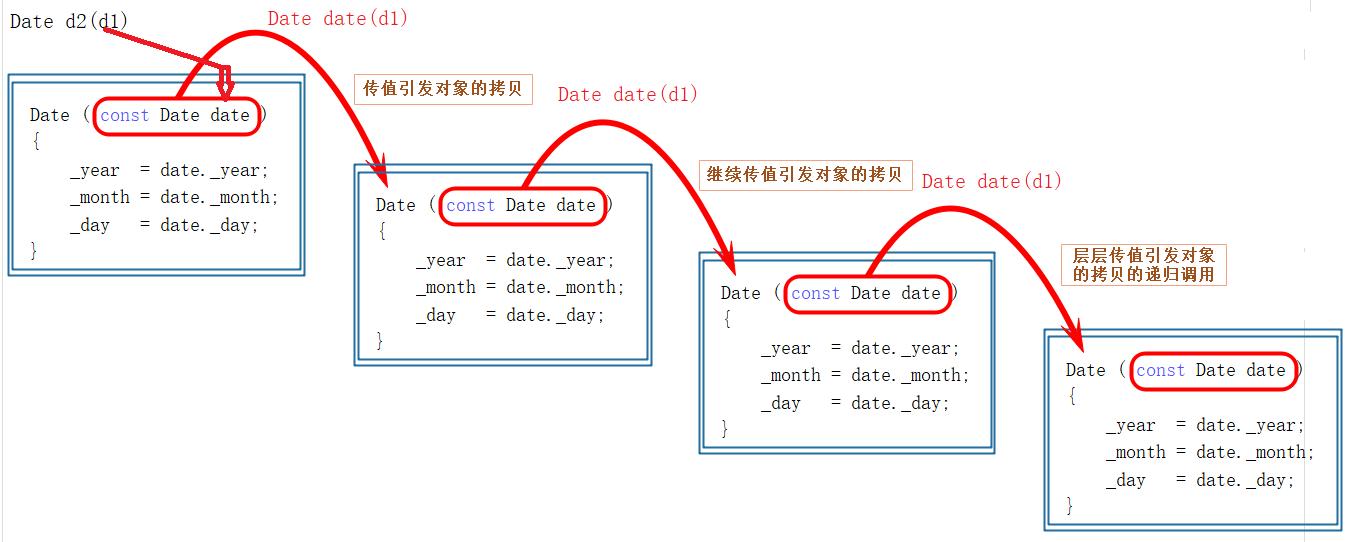
传值传参会引发对象的拷贝(形参是实参的拷贝),我们可以举个简单的例子,通过函数的调用即可知道:
class Date
{
public:
Date(int year=1, int month = 1, int day = 1)
{
_year = year;
_month = month;
_day = day;
}
//Date(const Date&d)——加上const修饰,防止写反
Date(Date& d)
{
cout << "Date的拷贝构造" << endl;
_year = d._year;
_month = d._month;
_day = d._day;
}
private:
int _year;
int _month;
int _day;
};
void Func1(Date d)
{
cout << "Func1()" << endl;
}
void Func2(Date& d)
{
cout << "Func2()" << endl;
}
int main()
{
Date d1(2022,11,11);//构造
Func1(d1);
Func2(d1);
return 0;
}

注意:如果我们没写拷贝构造函数,编译器会自动生成的默认拷贝构造函数的,内置类型是按照字节方式直接拷贝的,而自定义类型是调用其拷贝构造函数完成拷贝的。
class Date
{
public:
Date(int year = 1, int month = 1, int day = 1)
{
_year = year;
_month = month;
_day = day;
}
private:
int _year;
int _month;
int _day;
};
int main()
{
Date d1(2022, 9, 24);//构造
Date d2(d1);
return 0;
}

在这里,默认拷贝构造函数帮我们完成了拷贝。那我们以后就可以直接去用系统默认生成的拷贝构造函数了吗❓
不是的,具体情况具体处理。我们在来看一个例子,你就不会怎么认为了:
class Stack
{
public:
Stack(int capacity = 4)
{
_a = (int*)malloc(sizeof(int) * capacity);
if (_a == nullptr)
{
perror("malloc fail");
exit(-1);
}
_top = 0;
_capacity = capacity;
}
~Stack()
{
free(_a);
_a = nullptr;
_top = _capacity = 0;
}
void Push(int x)
{
_a[_top++] = x;
}
private:
int* _a;
int _top;
int _capacity;
};
int main()
{
Stack st1;
st1.Push(1);
st1.Push(2);
Stack st2(st1);
return 0;
}

虽然完成了拷贝,但是并不是我们想要的。程序最终会崩溃,同一块空间析构了两次(st2先析构)。这是浅拷贝,对于一些类可以,对于一些类不可以。此时很明显,默认生成的拷贝构造函数已经不能符合我们的要求了。下面我们来看看正确的做法(深拷贝)👇:
class Stack
{
public:
Stack(int capacity = 4)
{
_a = (int*)malloc(sizeof(int) * capacity);
if (_a == nullptr)
{
perror("malloc fail");
exit(-1);
}
_top = 0;
_capacity = capacity;
}
Stack(const Stack& st)
{
_a = (int*)malloc(sizeof(int) * st._capacity);
if (_a == nullptr)
{
perror("malloc fail");
exit(-1);
}
memcpy(_a, st._a, sizeof(int) * st._top);
_top = st._top;
_capacity = st._capacity;
}
~Stack()
{
free(_a);
_a = nullptr;
_top = _capacity = 0;
}
void Push(int x)
{
_a[_top++] = x;
}
private:
int* _a;
int _top;
int _capacity;
};
int main()
{
Stack st1;
st1.Push(1);
st1.Push(2);
Stack st2(st1);
st1.Push(3);
return 0;
}

==对于需要写析构函数的类(比如上面的栈),都需要写深拷贝的拷贝构造==
==对于不需要写析构函数的类(比如我们一直接触的日期Date类),默认生成的浅拷贝的构造函数就可以了==
五、赋值运算符重载
1.运算符重载
C++为了增强代码的可读性引入了运算符重载,运算符重载是具有特殊函数名的函数,也具有其返回值类型,函数名字以及参数列表,其返回值类型与参数列表与普通的函数类似。
函数名字为:关键字operator后面接需要重载的运算符符号。
函数原型:返回值类型 operator操作符(参数列表)
注意:
- 不能通过连接其他符号来创建新的操作符:比如operator@
- 重载操作符必须有一个类类型或者枚举类型的操作数
- 用于内置类型的操作符,其含义不能改变,例如:内置的整型+,不 能改变其含义
- 作为类成员的重载函数时,其形参看起来比操作数数目少1成员函数的操作符有一个默认的形参this,限定为第一个形参
- .* 、:: 、sizeof 、?: 、. 注意以上5个运算符不能重载。
话不多说,我们先来举个例子,这里以日期类作为基础:
class Date
{
public:
Date(int year = 1, int month = 1, int day = 1)
{
_year = year;
_month = month;
_day = day;
//检查日期是否合法
if (!(year >= 1
&& (month >= 1 && month <= 12)
&& (day >= 1 && day <= GetMonthDay(year, month))))
{
cout << "非法日期" << endl;
}
}
bool operator == (const Date& d2)
{
return _year == d2._year
&& _month == d2._month
&& _day == d2._day;
}
private:
int _year;
int _month;
int _day;
};
int main()
{
Date d1(2022, 9, 24);
Date d2(2022,9,25);
cout<<(d1 == d2)<<endl;//转换成d1.operator == (d2);
return 0
}

我们在来看看>,>=:
class Date
{
public:
Date(int year = 1, int month = 1, int day = 1)
{
_year = year;
_month = month;
_day = day;
//检查日期是否合法
if (!(year >= 1
&& (month >= 1 && month <= 12)
&& (day >= 1 && day <= GetMonthDay(year, month))))
{
cout << "非法日期" << endl;
}
}
bool operator == (const Date& d2)
{
return _year == d2._year
&& _month == d2._month
&& _day == d2._day;
}
bool operator>(const Date& d)
{
if (_year > d._year)
{
return true;
}
else if (_year == d._year && _month > d._month)
{
return true;
}
else if (_year == d._year && _month == d._month && _day > d._day)
{
return true;
}
return false;
}
bool operator >= (const Date & d)
{
return *this > d || *this == d;
}
private:
int _year;
int _month;
int _day;
};
int main()
{
Date d1(2022, 9, 24);
Date d2(2022,9,25);
cout << (d1 > d2) << endl;
cout<<(d1 == d2)<<endl;//转换成d1.operator == (d2);
cout << (d1 >= d2) << endl;
return 0;
}
那日期如何做到加上天数呢❓
class Date
{
public:
int GetMonthDay(int year, int month)
{
static int monthDayArray[13] = { 0,31,28,31,30,31,30,31,31,30,31,30,31 };
if (month == 2 && ((year % 4 == 0 && year % 100 != 0) || (year % 400 == 0)))
{
return 29;
}
else
{
return monthDayArray[month];
}
}
Date(int year = 1, int month = 1, int day = 1)
{
_year = year;
_month = month;
_day = day;
//检查日期是否合法
if (!(year >= 1
&& (month >= 1 && month <= 12)
&& (day >= 1 && day <= GetMonthDay(year, month))))
{
cout << "非法日期" << endl;
}
}
Date& operator += (int day)
{
_day += day;
while (_day >= GetMonthDay(_year, _month))
{
_day -= GetMonthDay(_year, _month);
_month++;
if (_month == 13)
{
++_year;
_month = 1;
}
}
return *this;
}
Date operator+(int day)
{
Date ret(*this);
ret += day;
return ret;
}
private:
int _year;
int _month;
int _day;
};
int main()
{
Date d1(2022, 9, 24);
d1 += 50;
d1 += 1000;
Date d2(2022, 9, 25);
Date d3(d2 + 1);
return 0;
}
到了这里,operator后面接需要重载的运算符符号我们已经有了大致的了解了,对于其他的运算符的具体实现——我们可以在目录第六点可以清楚的看到。
下面,继续我们的内容,我们还需要看的是赋值运算符的重载👇
2.赋值运算符重载
赋值重载既是默认成员函数,又是运算符重载。
void TestDate()
{
Date d1;
Date d2(2022, 10, 9);
Date d3(d2);//拷贝构造(初始化) 一个初始化另一个马上要创建的对象
d1 = d2;//赋值重载(复制拷贝) 已经存在两个对象之间拷贝
}
赋值重载实现:
class Date
{
public:
Date(int year = 1, int month = 1, int day = 1)
{
_year = year;
_month = month;
_day = day;
//检查日期是否合法
if (!(year >= 1
&& (month >= 1 && month <= 12)
&& (day >= 1 && day <= GetMonthDay(year, month))))
{
cout << "非法日期" << endl;
}
}
void Print()
{
cout << _year << "/" << _month << "/" << _day << endl;
}
//d1 = d2;
Date& operator = (const Date& d)
{
_year = d._year;
_month = d._month;
_day = d._day;
return *this;
}
private:
int _year;
int _month;
int _day;
};
void TestDate2()
{
Date d1;
d1.Print();
Date d2(2022, 10, 9);
Date d3(d2);//拷贝构造(初始化) 一个初始化另一个马上要创建的对象
Date d4 = d2;//拷贝构造
d1 = d2;//赋值重载(复制拷贝) 已经存在两个对象之间拷贝
d1.Print();
}
对于赋值重载(复制拷贝)和拷贝构造的区别:
赋值重载(复制拷贝) 已经存在两个对象之间拷贝
拷贝构造(初始化) 一个初始化另一个马上要创建的对象
赋值运算符主要有五点:
- 参数类型(如上的const Date& d)
- 返回值 (如上的Date&)
- 检测是否自己给自己赋值
- 返回*this
- 一个类如果没有显式定义赋值运算符重载,编译器也会生成一个,完成对象按字节序的值拷贝。 (类似于拷贝构造)
但是如果用编译器默认的赋值运算符重载又会发生什么❓(我们以栈类为例子)
class Stack
{
public:
Stack(int capacity = 4)
{
cout << "Stack(int capacity = 4)" << endl;
_a = (int*)malloc(sizeof(int) * capacity);
if (_a == nullptr)
{
perror("malloc fail");
exit(-1);
}
_top = 0;
_capacity = capacity;
}
Stack(const Stack& st)
{
cout << "Stack(const Stack&st" << endl;
_a = (int*)malloc(sizeof(int) * st._capacity);
if (nullptr == _a)
{
perror("malloc fail");
exit(-1);
}
memcpy(_a, st._a, sizeof(int) * st._top);
_top = st._top;
_capacity = st._capacity;
}
~Stack()
{
cout << "~Stack()" << endl;
free(_a);
_a = nullptr;
_top = _capacity = 0;
}
void Push(int x)
{
_a[_top++] = x;
}
private:
int* _a;
int _top;
int _capacity;
};
void TestStack()
{
Stack st1;
st1.Push(1);
st1.Push(2);
Stack st2;
st2.Push(3);
st2.Push(4);
st2.Push(5);
st2.Push(6);
st1 = st2;
}
int main()
{
TestStack();
return 0;
}
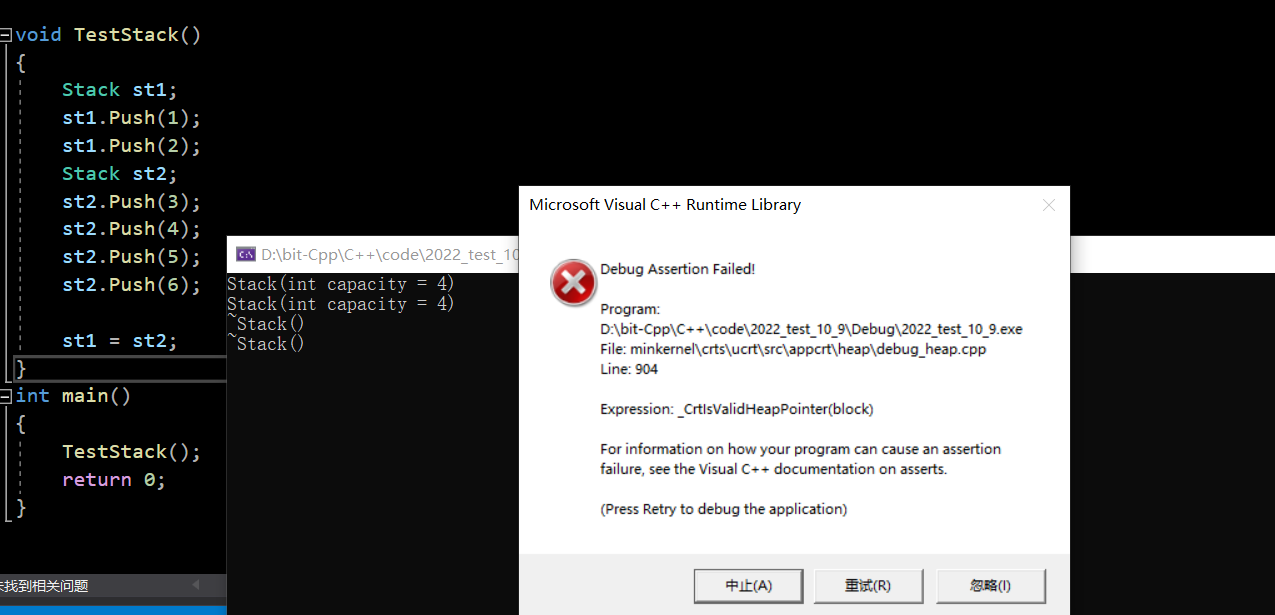
==发生了崩溃,实际上这里的问题还是析构了两次(直接把st2的空间拷贝给st1,st1和st2的_a指向了同一个)发生了崩溃,但是此时的st1的内存还发生了泄露==。栈的赋值运算符重载实现:
//st1 = st2;
//st1 = st1;
Stack& operator = (const Stack& st)
{
if (this != &st)
{
free(_a);
_a = (int*)malloc(sizeof(int) * st._capacity);
if (nullptr == _a)
{
perror("malloc fail");
exit(-1);
}
memcpy(_a, st._a, sizeof(int) * st._top);
_top = st._top;
_capacity = st._capacity;
}
return *this;
}
六、日期类的完善实现
至此,我们对于运算符的重载也有了清晰的认识。下面,我们对日期类的运算符重载进行相关的完善补充。
对于<<和>>,我们一般不写成员函数,因为this默认抢了第一个参数位置,Date对象就是左操作数,不符合使用习惯和可读性,这点值得我们去关注哈。但是如果写在全局,又引发了另一个问题:
如何去访问类的私有属性❓
1.直接把私有权限改为公共权限
2.在类中设置get和set方法,然后在类外直接调用即可
3.友元声明
同时,全局变量/全局函数在所有文件中(这里我们有Date.cpp,Date.h,test.cpp)都可见的,在经过编译会生成Date.o,test.o,此时里面都会有全局函数的定义,放进符号表,此时就会产生冲突。所以声明与定义应该进行分离。(也可以加上static进行修饰,static修饰全局函数会改变链接属性,只在当前文件可见)。所以尽量在。h文件中不要定义全局的函数
同时,对于频繁调用,我们可以直接用内联函数,直接展开,不进符号表
Date.h
#pragma once
#include <iostream>
using namespace std;
class Date
{
//友元声明(在类的任意位置)
friend ostream& operator<<(ostream& out, const Date& d);
friend istream& operator >>(istream& in, Date& d);
public:
int GetMonthDay(int year, int month)
{
static int monthDayArray[13] = { 0,31,30,31,30,31,30,31,31,30,31,30,31 };
if (month == 2 && ((year % 4 == 0 && year % 100 != 0) || (year % 400 == 0)))
{
return 29;
}
else
{
return monthDayArray[month];
}
}
Date(int year = 1, int month = 1, int day = 1)
{
_year = year;
_month = month;
_day = day;
if (!(year >= 1
&& (month >= 1 && month <= 12)
&& (day >= 1 && day <= GetMonthDay(year, month))))
{
cout << "非法日期" << endl;
}
}
void Print() const
{
cout << _year << "/" << _month << "/" << _day << endl;
}
bool operator == (const Date& d) const;
bool operator >(const Date& d) const;
bool operator >=(const Date& d) const;
bool operator <(const Date& d) const;
bool operator <=(const Date& d) const;
bool operator!=(const Date& d) const;
Date& operator+=(int day);
Date operator+(int day) const;
Date& operator-=(int day);
Date operator-(int day) const;
// 前置
Date& operator++();
// 后置
Date operator++(int);
// 前置
Date& operator--();
// 后置
Date operator--(int);
// d1 - d2
int operator-(const Date& d) const;
//不写成员函数
//d1.operator(cout);//d1<<cout
/*void operator<<(ostream& out)
{
out<<_year<<"年"<<_month<<"月"<<_day<<"日"<<endl;
}*/
/*Date* operator&()
{
return this;
}
const Date* operator&() const
{
return this;
}*/
private:
int _year;
int _month;
int _day;
};
//operator<<(cout,d1)
inline ostream& operator<<(ostream& out, const Date& d)
{
out << d._year << "年" << d._month << "月" << d._day << "日" << endl;
return out;
}
inline istream& operator >>(istream& in, Date& d)
{
in >> d._year >> d._month >> d._day;
return in;
}
Date.cpp
#include "Date.h"
bool Date::operator==(const Date& d) const
{
return _year == d._year
&& _month == d._month
&& _day == d._day;
}
// d1 > d2
bool Date::operator>(const Date& d) const
{
if (_year > d._year)
{
return true;
}
else if (_year == d._year && _month > d._month)
{
return true;
}
else if (_year == d._year && _month == d._month && _day > d._day)
{
return true;
}
return false;
}
bool Date::operator>=(const Date& d) const
{
return *this == d || *this > d;
}
bool Date::operator<=(const Date& d) const
{
return !(*this > d);
}
bool Date::operator<(const Date& d) const
{
return !(*this >= d);
}
bool Date::operator!=(const Date& d) const
{
return !(*this == d);
}
Date& Date::operator+=(int day)
{
if (day < 0)
{
return *this -= abs(day);
}
_day += day;
while (_day > GetMonthDay(_year, _month))
{
_day -= GetMonthDay(_year, _month);
_month++;
if (_month == 13)
{
++_year;
_month = 1;
}
}
return *this;
}
// d1 + 100
Date Date::operator+(int day) const
{
Date ret(*this);
ret += day;
return ret;
}
// d1 -= 100
Date& Date::operator-=(int day)
{
if (day < 0)
{
//return *this -= -day;
return *this += abs(day);
}
_day -= day;
while (_day <= 0)
{
--_month;
if (_month == 0)
{
--_year;
_month = 12;
}
_day += GetMonthDay(_year, _month);
}
return *this;
}
// d1 - 100
Date Date::operator-(int day) const
{
Date ret(*this);
ret -= day;
return ret;
}
// 前置
Date& Date::operator++()
{
*this += 1;
return *this;
}
// 后置 -- 多一个int参数主要是为了根前置区分
// 构成函数重载
Date Date::operator++(int)
{
Date tmp(*this);
*this += 1;
return tmp;
}
// 运算符重载
// 函数重载
// 前置
Date& Date::operator--()
{
*this -= 1;
return *this;
}
// 后置
Date Date::operator--(int)
{
Date tmp = *this;
*this -= 1;
return tmp;
}
// d1 - d2
int Date::operator-(const Date& d) const
{
Date max = *this;
Date min = d;
int flag = 1;
if (*this < d)
{
max = d;
min = *this;
flag = -1;
}
int n = 0;
while (min != max)
{
++n;
++min;
}
return n * flag;
}
//ostream& operator<<(ostream& out, const Date& d)
//{
// out << d._year << "年" << d._month << "月" << d._day << "日" << endl;
// return out;
//}
七、const成员
const修饰类的成员函数将const修饰的类成员函数称之为const成员函数,const修饰类成员函数,实际修饰该成员函数隐含的this指针,表明在该成员函数中不能对类的任何成员进行修改。
对于const的修饰,我们要注意权限可以进行缩小和平移,但是不能进行放大,这是在之前对于this指针( *const this)所说的。
简单来说,凡是内部不改变成员变量,其实也就是*this对象数据的,这些成员函数都应该加const
class Date
{
public :
void Display ()
{
cout<<"Display ()" <<endl;
cout<<"year:" <<_year<< endl;
cout<<"month:" <<_month<< endl;
cout<<"day:" <<_day<< endl<<endl ;
}
void Display () const
{
cout<<"Display () const" <<endl;
cout<<"year:" <<_year<< endl;
cout<<"month:" <<_month<< endl;
cout<<"day:" <<_day<< endl<<endl;
}
private :
int _year ; // 年
int _month ; // 月
int _day ; // 日
};
void Test ()
{
Date d1 ;
d1.Display ();
const Date d2;
d2.Display ();
}
八、 取地址及const取地址操作符重载
这两个默认成员函数一般不用重新定义 ,编译器默认会生成
class Date
{
public:
Date* operator&()
{
return this;
}
const Date* operator&()const
{
return this;
}
private:
int _year; // 年
int _month; // 月
int _day; // 日
};
这两个运算符一般不需要重载,使用编译器生成的默认取地址的重载即可,只有特殊情况,才需要重载,比如想让别人获取到指定的内容。至此,内容比较多了,我们先到这里结束掉我们的类和对象(中)内容
- 点赞
- 收藏
- 关注作者


评论(0)